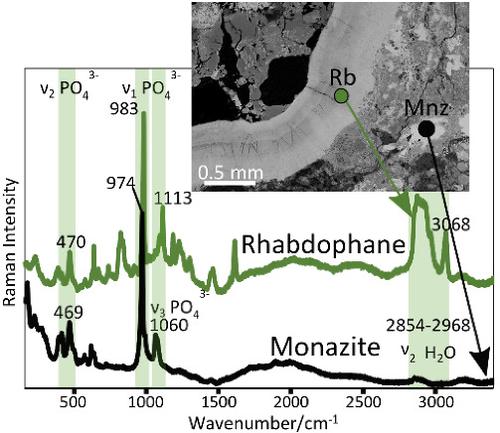当前位置:
X-MOL 学术
›
J. Raman Spectrosc.
›
论文详情
Our official English website, www.x-mol.net, welcomes your
feedback! (Note: you will need to create a separate account there.)
Application of Raman spectroscopy for the identification of phosphate minerals from REE supergene deposit
Journal of Raman Spectroscopy ( IF 2.4 ) Pub Date : 2021-07-28 , DOI: 10.1002/jrs.6213 Irina A. Zhukova 1 , Aleksandr S. Stepanov 1 , Andrey V. Korsakov 2 , Shao‐Yong Jiang 1
Journal of Raman Spectroscopy ( IF 2.4 ) Pub Date : 2021-07-28 , DOI: 10.1002/jrs.6213 Irina A. Zhukova 1 , Aleksandr S. Stepanov 1 , Andrey V. Korsakov 2 , Shao‐Yong Jiang 1
Affiliation

|
Among critical metals, rare-earth elements (REEs) are irreplaceable for their role in the high-tech industry. The REE deposits commonly host REEs in fine-grained mixtures of phosphate minerals characterized by the variable content of volatile components. However, identification of the volatile components may present challenges for laser-ablation inductively coupled plasma mass spectrometer (LA-ICP-MS) and electron microprobe (EPMA) techniques. Therefore, Raman spectroscopy was applied to laterite and carbonatite samples from the Mount Weld deposit, one of the major REE deposits in Western Australia. The hydrous REE phosphate, rhabdophane, can be confidently distinguished from monazite by the presence of peaks in the region 2800–3600 cm−1. The presence of peaks at 428, 448, 579, 589, and 605 cm−1 in the Raman spectra of apatite from carbonatite allows its identification as hydroxyfluorapatite with high concentrations of F and water, and negligible Cl, SO42−, and SiO42−. The Raman spectra and composition of silcrete and carbonatite apatite are similar; thus, silcrete apatite was identified as hydroxyfluorapatite as well. The content of CO32− in both types of apatite was negligible despite the crystallization from carbonatitic magma. The aluminophosphate florencite is characterized by the presence of PO43−-related peaks at 639, 1113, and 1609 cm−1 and H2O/OH-related bands in the 2750–3075 cm−1 and together with rhabdophane has been identified in fine-grained mineral mixtures. Our study demonstrates that combining Raman spectroscopy with compositional data is a powerful method for the characterization of phosphate minerals in REE deposits.
中文翻译:

拉曼光谱在稀土表生矿床磷酸盐矿物鉴定中的应用
在关键金属中,稀土元素 (REE) 在高科技产业中的作用不可替代。REE 矿床通常含有 REEs 在磷酸盐矿物的细粒混合物中,其特征在于挥发性成分含量的变化。然而,挥发性成分的识别可能会给激光烧蚀电感耦合等离子体质谱仪 (LA-ICP-MS) 和电子探针 (EPMA) 技术带来挑战。因此,拉曼光谱被应用于来自 Mount Weld 矿床的红土和碳酸盐岩样品,该矿床是西澳大利亚主要的 REE 矿床之一。通过在 2800-3600 cm -1区域中存在峰,可以可靠地区分含水 REE 磷酸盐、弹纹多芬和独居石。在 428、448、579、589 和 605 cm -1处存在峰在来自碳酸岩的磷灰石的拉曼光谱中,可以将其识别为具有高浓度 F 和水以及可忽略不计的 Cl、SO 4 2-和 SiO 4 2-的羟基氟磷灰石。硅石和碳酸磷灰石的拉曼光谱和成分相似;因此,硅磷灰石也被鉴定为羟基氟磷灰石。尽管从碳酸盐岩浆中结晶,两种类型的磷灰石中CO 3 2-的含量都可以忽略不计。磷酸铝萤石的特征在于在 639、1113和 1609 cm -1处存在 PO 4 3-相关峰,在 2750–3075 cm -1处存在H 2 O/OH 相关峰并已在细粒矿物混合物中鉴定出与 rhabdophane 一起。我们的研究表明,将拉曼光谱与成分数据相结合是表征 REE 矿床中磷酸盐矿物的有效方法。
更新日期:2021-07-28
中文翻译:

拉曼光谱在稀土表生矿床磷酸盐矿物鉴定中的应用
在关键金属中,稀土元素 (REE) 在高科技产业中的作用不可替代。REE 矿床通常含有 REEs 在磷酸盐矿物的细粒混合物中,其特征在于挥发性成分含量的变化。然而,挥发性成分的识别可能会给激光烧蚀电感耦合等离子体质谱仪 (LA-ICP-MS) 和电子探针 (EPMA) 技术带来挑战。因此,拉曼光谱被应用于来自 Mount Weld 矿床的红土和碳酸盐岩样品,该矿床是西澳大利亚主要的 REE 矿床之一。通过在 2800-3600 cm -1区域中存在峰,可以可靠地区分含水 REE 磷酸盐、弹纹多芬和独居石。在 428、448、579、589 和 605 cm -1处存在峰在来自碳酸岩的磷灰石的拉曼光谱中,可以将其识别为具有高浓度 F 和水以及可忽略不计的 Cl、SO 4 2-和 SiO 4 2-的羟基氟磷灰石。硅石和碳酸磷灰石的拉曼光谱和成分相似;因此,硅磷灰石也被鉴定为羟基氟磷灰石。尽管从碳酸盐岩浆中结晶,两种类型的磷灰石中CO 3 2-的含量都可以忽略不计。磷酸铝萤石的特征在于在 639、1113和 1609 cm -1处存在 PO 4 3-相关峰,在 2750–3075 cm -1处存在H 2 O/OH 相关峰并已在细粒矿物混合物中鉴定出与 rhabdophane 一起。我们的研究表明,将拉曼光谱与成分数据相结合是表征 REE 矿床中磷酸盐矿物的有效方法。











































 京公网安备 11010802027423号
京公网安备 11010802027423号